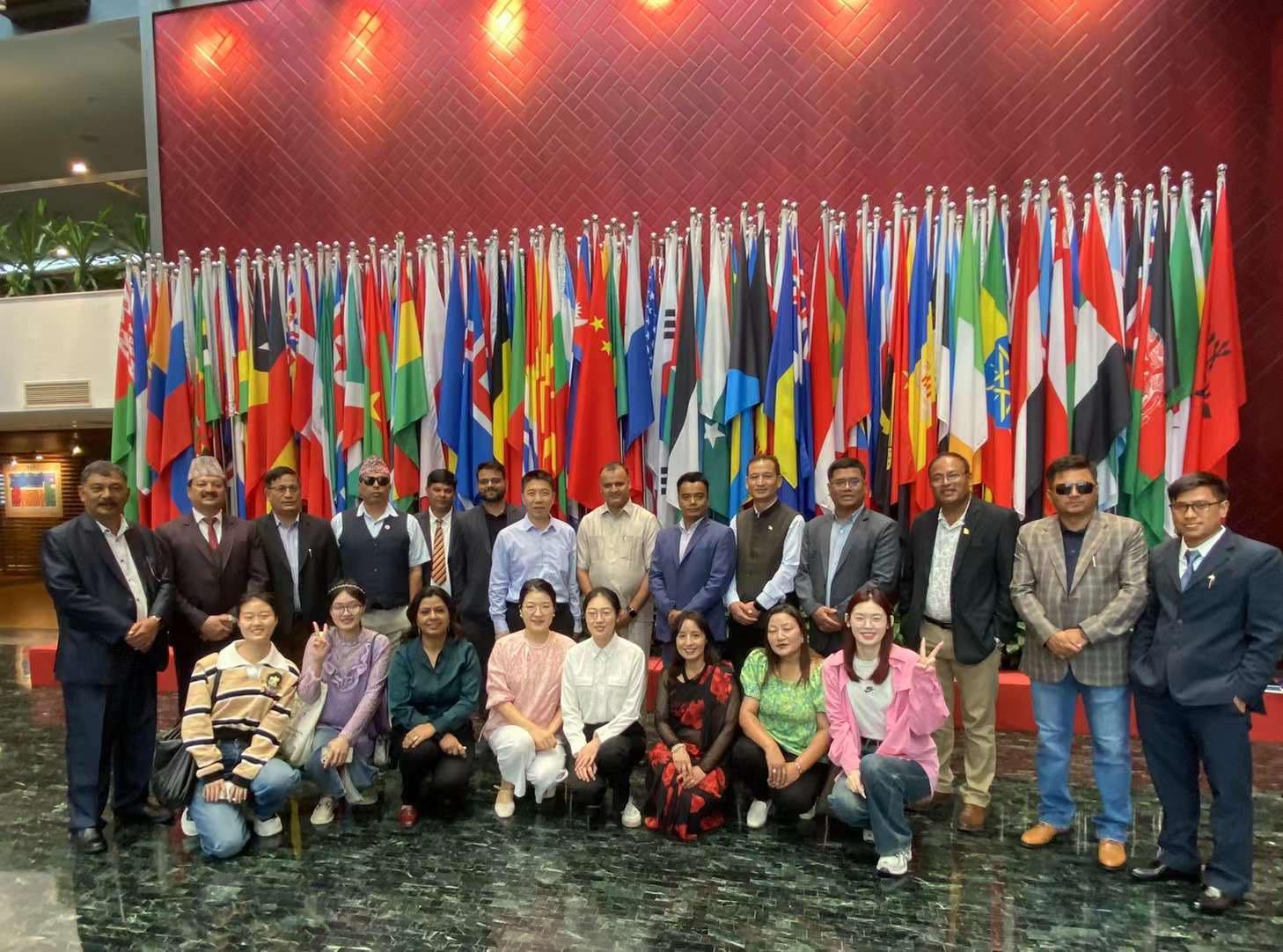
The Journey marks the beginning of an extraordinary adventure – my sponsored trip to China! I am filled with a mix of anticipation, curiosity, and gratitude as I embark on this journey, made possible by the generous support of Confucius Institute at Kathmandu University and Prime College. This visit is especially unique as I was invited by the esteemed Hebei University professor and the Confucius Center for the Development of Chinese Language. It was an amazing opportunity to immerse myself in the vibrant Chinese culture and learn more about its rich history.
As soon as I arrived in China, I was immediately captivated by the bustling streets, filled with a symphony of sights, sounds, and smells. The vibrant energy of the city is infectious, and it’s clear that there is so much to explore and discover here. The warm welcome I received from the Confucius Center made me feel right at home, and I am grateful for their hospitality.
Unlocking China’s Riches: A Journey of Exploration for Education
China is known as the economic powerhouse of Asia with its vibrant culture, rich history, and remarkable achievements. As a part of an educators’ delegation summer camp, I embarked on a journey to this incredible land upon the invitation of Hebei University of Economics and Business. This sponsored trip was not only a travel adventure but an opportunity for profound educational experience. Our mission was to unraveling its language and culture, and attaining insights that could contribute to the landscape of Chinese language education in Nepal.
A Tapestry of Experiences
Our delegation, comprising of 16 educators from diverse organizations, was set to explore a tapestry of experiences across Chinese historic as well as modern cities. It was an immersion trip to the iconic Tiananmen Square in Beijing to the ancient charm of Zhengding, and the corporate world of Shijiazhuang Junlebao Company to the mesmerizing art of Chinese acrobatics at Wuqiao Acrobatics World; the journey was a symphony of culture and history.
Historic Treasures and Modern Marvels
Our initial days in Beijing took us to historic gems like Tiananmen Square and the Forbidden City, offering a glimpse into Chinese imperial history. We marveled at the intricate architecture and delved into the significance of these sites. It was an exploration of history that enriched our understanding of Chinese cultural roots.
Chinese art had an influence of Nepalese art on certain architectural elements particularly to Ming and Qing dynasties. The Temple of Heaven and Summer Palace in Beijing are its examples.
In the 15th century, during the Ming Dynasty, Chinese emperors imported architects and artisans from Nepal to work on these imperial projects. The most notable influence can be seen in the design of temple roofs, where pagoda-like structures with multiple tiers and upturned leaves resemble traditional Nepalese architecture. This style is known as “Nepalese Pavilion.”
The Nepalese artisans also contributed to the intricate woodcarvings and decorative elements found in these structures. While these influences are not dominant, they are distinct and showcase of cultural exchange and artistic blending that occurred during that period.
Thus, the Temple of Heaven and Summer Palace do indeed reflect elements of Nepalese art of the ancient period, demonstrating the rich cross-cultural interactions in Chinese history.
The Great Wall and the Bird’s Nest
The visit to the Great Wall of China was short of a transcendental experience. The ancient marvel snaking through rugged terrain left us humbled by the sheer determination and ingenuity of the builders. In contrast, the Bird’s Nest Stadium in Beijing embodies Chinese modern architectural progress and a testimony to its rapid development.
Corporate Culture and Bridge to History
Shijiazhuang Junlebao Company gave us a glimpse into Chinese corporate culture, emphasizing innovation and sustainability. Junlebao is a leading dairy brand in China, it has significant contributions to the dairy industry in China. As educators, we are pondering how we can adopt same into Nepalese educational system of entrepreneurship with broad thinking. Since Nepal is an agricultural country, She can learn a lot from Junlebabo. Here are few lessons that Nepal can consider adopt:
- Emphasize Quality and Safety: Following Junlebao’s example, Nepal can prioritize the quality and safety of its agricultural products. Implementing stringent quality control measures and food safety standards, they can help ensure consumers with safe and high-quality agricultural products.
- Foster Innovation: Nepal can invest in research and development, promote entrepreneurship, and provide support to farmers and agribusinesses to foster innovation. Encouraging innovation in the agricultural sector can lead to the development of new and unique products that can cater to the changing consumer preferences.
- Promote Sustainable Farming: Nepal can learn from Junlebao’s commitment to sustainable farming practices. Implementing environmentally friendly practices, such as efficient resource usage, organic farming, and responsible waste management can help minimize the environmental impact in agricultural sector.
Language and Education
One of our core objectives was to understand the significance of Chinese language and culture and education in Nepal. The immersion program at Shijiazhuang Foreign Language Middle School highlighted the effectiveness of language education through cultural exchange. Finally, we left with a vision of revamping language education in Nepal to be more effective and culturally enriching.
Cultural Enrichment and Exchange
In Wuqiao, we were spellbound by the art of Chinese acrobatics. It made us to rethink about the importance of cultural exchange program. Its introduction was unique Nepalese students for broadening their horizons and instilling a deep appreciation for diverse art forms.
Economic Insights
Transformation of Chinese economy into superpower house is impressive. The Small Commodity Market showed us the dynamism of Chinese trade sectors and it prompted us to explore how similar models could be adopted in Nepal.
Nepal can consider adopting several strategies and practices from Chinese economy to foster the development of its businesses and economy. Here are some key areas to focus on:
- Infrastructure Development: China has invested heavily in infrastructure, including transportation networks, ports, and energy projects. Nepal can prioritize infrastructure development to improve connectivity, logistics, and overall business efficiency.
- Special Economic Zones (SEZs): Establishing SEZs can attract foreign investment, promote exports, and create jobs. These zones offer incentives and streamlined regulations to encourage business growth.
- E-Government and Digitalization: China has made strides in digitalization and e-government services. Nepal can enhance its digital infrastructure, promote e-commerce, and facilitate online government services to streamline business processes.
- Manufacturing and Export Promotion: Chinese success in manufacturing and exports can serve as a model. Nepal should focus on building competitive industries, improving product quality, and diversifying export markets.
- Foreign Investment Promotion: China has attracted foreign investment through various policies and incentives. Nepal can adopt similar approaches to encourage foreign direct investment (FDI).
- Education and Workforce Development: China emphasizes strongly on education and skill development. Investing in education and vocational training can help Nepalese workforce become more competitive in the global market.
- Infrastructure for Tourism: China has developed infrastructure to support its booming domestic tourism industry. Nepal can invest in improving tourist facilities, accessibility to popular destinations, and marketing its unique attractions.
- Trade Agreements: China has an extensive network of trade agreements. Nepal can explore trade partnerships and regional cooperation to expand market access for its businesses.
- Green Initiatives: China has been working on environmental sustainability and green technologies. Nepal, with its rich natural resources, can prioritize eco-friendly practices and clean energy solutions.
- 10. Innovation and Technology Transfer: Promoting innovation and technology transfer can help Nepalese businesses stay competitive. Collaboration with Chinese companies or institutions can facilitate this.
- Entrepreneurship and Startups: Encouraging entrepreneurship and providing support for startups can foster economic growth. Learning from Chinese successful startup ecosystem can be beneficial.
- Infrastructure Financing: Nepal can explore Chinese-led financing initiatives like the Belt and Road Initiative (BRI) for infrastructure development projects.
It’s important to adapt these practices to Nepal’s specific context and needs while considering its own economic and political situation. Additionally, maintaining a balanced approach to economic development, environmental sustainability, and social inclusion is crucial for long-term success.
Conclusion:
China, with its blend of history, language and culture offer wealth of knowledge for innovation. As educators, we returned to Nepal not only with fond of memories but also with new impression. This visit drastically changed our perception about Chinese society as we received wonderful hospitality with helpful attitude. We are highly encouraged by the future roadmap for new generation being adopted in the Chinese education system with culture of art for innovation. This journey not only provided us with rich Chinese hospitality experience but it also enriched our minds with lot of knowledge of Chinese history and modern innovation. China has much to offer Nepal. This journey has not only been a summer camp; it was a transformative voyage of learning for encouragement and innovation to Nepalese entrepreneurship.
A visit to Beijing and Hebei University was historic. We are filled profound appreciation for the significance of Chinese language and cultural education in Nepal. We have been inspired to foster cultural exchanges and educational collaborations between our organizations.
This delegation was a testament to the power of education and cross-cultural experiences in bridging divides and building stronger connections between people to people. Our hearts are filled with gratitude for the warm hospitality of our hosts, and our minds are enriched with the knowledge and experiences gained during this remarkable journey. The volunteers of Hebei University were so helpful and dedicated in our service that we can never forget them.
Dinesh Shreshtha
Administrative Director
Prime Educational Inc.





